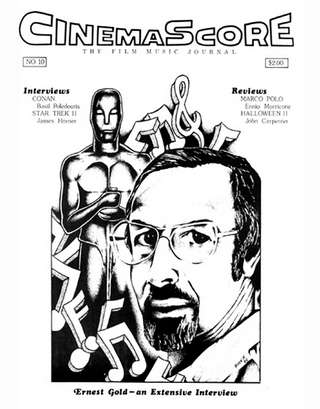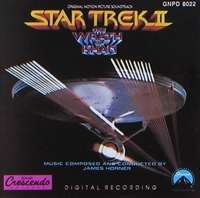[divider]Interview: James Horner and Star Trek II[/divider]
excerpted from CinemaScore, issue # 10, Fall 1982; reviewed and interviewed by Randall D. Larson.
After scoring a series of low-budget horror films for New World Pictures, composer James Horner has finally been given an assignment which allows him to rise above the derivative nature of much of his earlier work. While his intriguing score for Wolfen (1981) helped elevate him into the big-budget film world,  his expansive music for Star Trek II: The Wrath of Khan provides Horner with an arena to demonstrate the type of dramatic scoring he is best at.
his expansive music for Star Trek II: The Wrath of Khan provides Horner with an arena to demonstrate the type of dramatic scoring he is best at.
 his expansive music for Star Trek II: The Wrath of Khan provides Horner with an arena to demonstrate the type of dramatic scoring he is best at.
his expansive music for Star Trek II: The Wrath of Khan provides Horner with an arena to demonstrate the type of dramatic scoring he is best at.
Horner, who studied and eventually taught at UCLA, left the academic field in 1978 and began scoring films. After composing music for several independent pictures, he got his first break through Roger Corman of New World Pictures, for whom he scored films such as Lady in Red, Humanoids From the Deep, and the powerful, if highly imitative, Battle Beyond the Stars. Horner was able to branch out in 1981 when he was hired by Orion Pictures to score The Hand, and later that same year, Wolfen. Horner also wrote music for Polygram's Deadly Blessing and The Pursuit of D.B. Cooper before being signed to score the long awaited sequel to Star Trek: The Motion Picture.
Some critics have noted with irony that it's fitting to have Horner score Star Trek II, since the first movie had such a popular score by Jerry Goldsmith, the same composer whose style seemed to figure so prominently in much of Horner's earlier work. Horner, although confessing a strong degree of influence from Goldsmith, claims that, rather than any intentional imitation of his own, the fault most often lay with producers who wanted a scored to sound just like someone else's popular film.
"That is often what one is up against," Horner explained. "A producer or director has seen the move and test-tracked it with somebody else's music and has fallen in love with that score, and says; this is what we want, period."
Despite such restrictions, Horner feels confident that his own voice will develop as he continues to write.
Star Trek II provides such an opportunity, in this case, producer Harve Bennet and director Nicholas Meyer wanted the score not to sound like Goldsmith's previous music. "They did not want the kind of score they had gotten before," Horner said. "they did not want a John Williams score,  per se. They wanted something different, more modern." Horner's score is a good one, balancing the sweeping scope of the science fiction adventure with the warm intimacies of the characters, Much of the music retains the "bubbly" brass feel of Horner's earlier Battle Beyond the Stars.
per se. They wanted something different, more modern." Horner's score is a good one, balancing the sweeping scope of the science fiction adventure with the warm intimacies of the characters, Much of the music retains the "bubbly" brass feel of Horner's earlier Battle Beyond the Stars.
 per se. They wanted something different, more modern." Horner's score is a good one, balancing the sweeping scope of the science fiction adventure with the warm intimacies of the characters, Much of the music retains the "bubbly" brass feel of Horner's earlier Battle Beyond the Stars.
per se. They wanted something different, more modern." Horner's score is a good one, balancing the sweeping scope of the science fiction adventure with the warm intimacies of the characters, Much of the music retains the "bubbly" brass feel of Horner's earlier Battle Beyond the Stars.
Director Meyer wanted a nautical sound to the main theme, "He wanted something very sea-faring, something that gave the feeling of space as an ocean, and I tried to achieve that without getting to literal about it." The main theme, which represents the Enterprise and the character of Kirk (the primary heroic elements of the Star Trek milieu), is a very flowing theme. Its melodic line is somewhat complex, in terms of its many notes, but it is a heroic theme that effectively captures the power and might of the Enterprise.
In contrast, the theme for Khan, Kirk's nemesis, is more of an effect-texture than a melody, quietly emphasizing Khan's insanity. This motif works well when combined with the Enterprise theme. "You can lay the texture over the theme," Horner explained, "and when it works with the picture, it's terrific. It's a very simple device and it works very well."
In addition to these two fundamental themes, Horner composed a haunting motif for Spock, one  which emphasizes his human side through the warm use of conventional instruments rather than alien-sounding electronics. As the composer explained in an interview for Cinefantastique magazine, "by putting a theme over Spock, it warms him and he becomes three-dimensional rather than a collection of schticks." Horner also composed a theme for the Genesis Effect, as it transforms the barren planet of Gamma Regula into a lush paradise. Instead of using a Stravinsky-like overture, Horner utilized "large sustained orchestral chords which slowly and almost imperceptible change," as he described it to Kay Anderson of Cinefantasique.
which emphasizes his human side through the warm use of conventional instruments rather than alien-sounding electronics. As the composer explained in an interview for Cinefantastique magazine, "by putting a theme over Spock, it warms him and he becomes three-dimensional rather than a collection of schticks." Horner also composed a theme for the Genesis Effect, as it transforms the barren planet of Gamma Regula into a lush paradise. Instead of using a Stravinsky-like overture, Horner utilized "large sustained orchestral chords which slowly and almost imperceptible change," as he described it to Kay Anderson of Cinefantasique.
 which emphasizes his human side through the warm use of conventional instruments rather than alien-sounding electronics. As the composer explained in an interview for Cinefantastique magazine, "by putting a theme over Spock, it warms him and he becomes three-dimensional rather than a collection of schticks." Horner also composed a theme for the Genesis Effect, as it transforms the barren planet of Gamma Regula into a lush paradise. Instead of using a Stravinsky-like overture, Horner utilized "large sustained orchestral chords which slowly and almost imperceptible change," as he described it to Kay Anderson of Cinefantasique.
which emphasizes his human side through the warm use of conventional instruments rather than alien-sounding electronics. As the composer explained in an interview for Cinefantastique magazine, "by putting a theme over Spock, it warms him and he becomes three-dimensional rather than a collection of schticks." Horner also composed a theme for the Genesis Effect, as it transforms the barren planet of Gamma Regula into a lush paradise. Instead of using a Stravinsky-like overture, Horner utilized "large sustained orchestral chords which slowly and almost imperceptible change," as he described it to Kay Anderson of Cinefantasique.
While avoiding any specific reference to Goldsmith's earlier Star Trek score, Horner did make moderate use of the opening fanfare from the original television series in a few places, at the request of the producers.
"At first I was not going to do it, but then as I started writing the music I figured out a way to incorporate part of the fanfare into the music, and it works very well. I felt it was very important to Star Trek to somehow tie in the characters and the ship that everybody knew."
The use of the fanfare has a very nostalgic feel to it, and brings with it a marvelous feeling of history, of legendry and heroic importance to the Enterprise and its crew. It characterizes the whole Star Trek mythology. "The audience seems to like it. When they first hear the music they start applauding!"
Nicholas Meyer, who previously directed Time After Time and saw to it that none other than Miklos Rozsa provided the right kind of symphonic score, worked very closely with Horner on Star Trek II. Meyer, an avid classical music fan, was able to describe through musical terms that Horner was able to understand, and this made for a harmonious collaboration between them, as well as producer Bennet.
"The three of us basically decided the way the score was supposed to go, but they gave me a lot of freedom to do it my own way."
Horner was given four and a half weeks to write the score, which came to a total of 72 minutes worth of music, which was then recorded by a 94-piece orchestra.
While Horner found working on the films a very enjoyable experience, it was not without its problems–one of which was in the frequent change in length of the scenes he was scoring due to unpredicted changes in the special effects footage. The visual effects sequences were shipped daily to Hollywood from the ILM effects studio in Northern California.
"There were quite a few instances where I would be called up on a sequence that we had timed out, asking to change lengths because they couldn't use the full special effects shot, or they had lengthened it or re-cut it slightly." If Horner had already written the music for one of these sequences, it meant a lot of work to change the cue's orchestration to fit the new timing.
James Horner prefers to write dramatic scores as well as tender stories have dramatic underscoring. With Star Trek II he has found an opportunity to excel in both those areas. The large nature of this film, and its pre-sold popularity, may give Horner the boost he needs to achieve greater recognition in the film music field. It should also maintain his position of choosing films that will enable his music to be heard rather than limiting him to musical whims of the imitative producers and directors of his early days.




